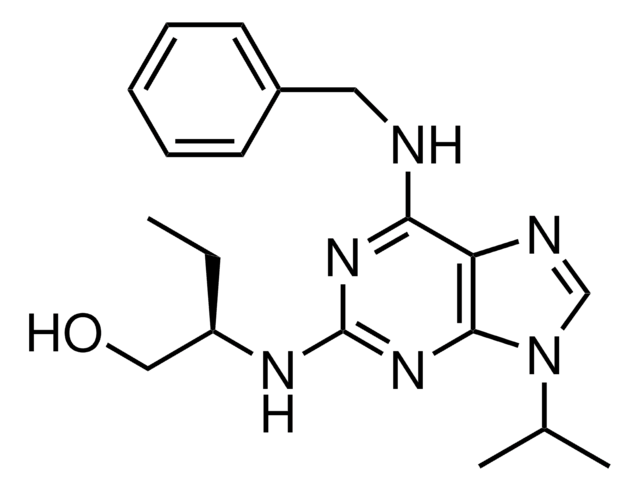P0042
PP2
≥98% (HPLC)
Synonym(s):
4-Amino-3-(4-chlorophenyl)-1-(t-butyl)-1H-pyrazolo[3,4-d]pyrimidine, 4-Amino-5-(4-chlorophenyl)-7-(t-butyl)pyrazolo[3,4-d]pyrimidine, AG 1879
About This Item
Recommended Products
Quality Level
Assay
≥98% (HPLC)
form
powder
color
white to off-white
solubility
DMSO: >10 mg/mL
storage temp.
2-8°C
SMILES string
CC(C)(C)n1nc(-c2ccc(Cl)cc2)c3c(N)ncnc13
InChI
1S/C15H16ClN5/c1-15(2,3)21-14-11(13(17)18-8-19-14)12(20-21)9-4-6-10(16)7-5-9/h4-8H,1-3H3,(H2,17,18,19)
InChI key
PBBRWFOVCUAONR-UHFFFAOYSA-N
Application
- to analyze the effects of Src/focal adhesion kinase (FAK) signaling on IQ domain GTPase-activating protein 1 (IQGAP1)-mediated anoikis resistance
- for Src inhibition to study its effect on epidermal growth factor receptor (EGFR) and nuclear factor erythroid 2-related factor 2 (Nrf2) phosphorylation in non-small cell lung cancer (NSCLC) cells
- for pharmacological inhibition of SRC in MDA-MB-231 breast cancer cells
Biochem/physiol Actions
Features and Benefits
Signal Word
Danger
Hazard Statements
Precautionary Statements
Hazard Classifications
Acute Tox. 3 Oral
Storage Class Code
6.1C - Combustible acute toxic Cat.3 / toxic compounds or compounds which causing chronic effects
Flash Point(F)
Not applicable
Flash Point(C)
Not applicable
Certificates of Analysis (COA)
Search for Certificates of Analysis (COA) by entering the products Lot/Batch Number. Lot and Batch Numbers can be found on a product’s label following the words ‘Lot’ or ‘Batch’.
Already Own This Product?
Find documentation for the products that you have recently purchased in the Document Library.
Customers Also Viewed
Related Content
Discover Bioactive Small Molecules for Kinase Phosphatase Biology
Our team of scientists has experience in all areas of research including Life Science, Material Science, Chemical Synthesis, Chromatography, Analytical and many others.
Contact Technical Service










